Polarization
 I'll answer that, Kyla, but first we're going to have to talk about
polarized light. Think back to when we talked about electromagnetic
waves. We learned that the
electric force field moves up and down as the electromagnetic wave moves
forward. The light is brightest when the blue electric force arrow is biggest,
and it is dark where it is zero.
I'll answer that, Kyla, but first we're going to have to talk about
polarized light. Think back to when we talked about electromagnetic
waves. We learned that the
electric force field moves up and down as the electromagnetic wave moves
forward. The light is brightest when the blue electric force arrow is biggest,
and it is dark where it is zero.
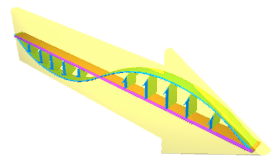
 It still seems strange to think about a force field that moves in a different
direction than the light, but I guess light is just one example of the
electromagnetic waves we talked about earlier.
It still seems strange to think about a force field that moves in a different
direction than the light, but I guess light is just one example of the
electromagnetic waves we talked about earlier.
 You're exactly right, Kyla. In general, the direction the wave moves is
called the "ray" direction. This "ray" direction points along the path of
light "rays".
You're exactly right, Kyla. In general, the direction the wave moves is
called the "ray" direction. This "ray" direction points along the path of
light "rays".
 You mean like the light rays coming through a window into a dusty room?
You mean like the light rays coming through a window into a dusty room?
 Yes. That and most light is NOT polarized, although the electric forces still
move up and down perpendicular to the ray direction. In the picture above, the
light is polarized in the plane of the yellow arrow. Unpolarized light looks
more like the movie below.
Yes. That and most light is NOT polarized, although the electric forces still
move up and down perpendicular to the ray direction. In the picture above, the
light is polarized in the plane of the yellow arrow. Unpolarized light looks
more like the movie below.
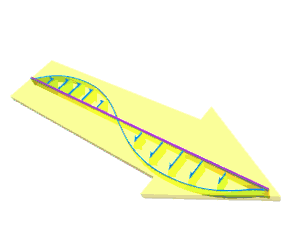
 It looks like the yellow arrow plane keeps jumping to a different angle, even
though the ray direction remains the same.
It looks like the yellow arrow plane keeps jumping to a different angle, even
though the ray direction remains the same.
 That's right, but notice that no matter how the yellow arrow twists, the
electric forces are always perpendicular to the ray direction. In unpolarized
light the twist of the yellow arrow plane keeps changing randomly. We will use
the picture below on the left as a symbol for polarized light, and the picture
on the right as a symbol for unpolarized light.
That's right, but notice that no matter how the yellow arrow twists, the
electric forces are always perpendicular to the ray direction. In unpolarized
light the twist of the yellow arrow plane keeps changing randomly. We will use
the picture below on the left as a symbol for polarized light, and the picture
on the right as a symbol for unpolarized light.
 |
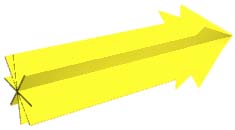 |
|
| Polarized Light | Unpolarized Light |
 If the yellow plane of polarization is always twisting in unpolarized light,
how is it possible to transform unpolarized light into polarized light where
the plane doesn't change?
If the yellow plane of polarization is always twisting in unpolarized light,
how is it possible to transform unpolarized light into polarized light where
the plane doesn't change?
 That's a good question, Kyla. The electric force field in any plane of light
can be separated into a vertical and horizontal component, so you can think of
a diagonal plane of light as being made up of some vertical polarized light
and some horizontal polarized light. A good way to picture this is to imagine
pushing a heavy box.
That's a good question, Kyla. The electric force field in any plane of light
can be separated into a vertical and horizontal component, so you can think of
a diagonal plane of light as being made up of some vertical polarized light
and some horizontal polarized light. A good way to picture this is to imagine
pushing a heavy box.
 You can push the box along the diagonal by yourself, but you will have to
push pretty hard to move it. On the other hand, you can get a friend to
push it to the right while you push it forward, and the box will end up in
the same place. Because the two of you are pushing together, neither one of
you will have to push as hard as if you were pushing alone.
You can push the box along the diagonal by yourself, but you will have to
push pretty hard to move it. On the other hand, you can get a friend to
push it to the right while you push it forward, and the box will end up in
the same place. Because the two of you are pushing together, neither one of
you will have to push as hard as if you were pushing alone.
 |
 |
 |
 |
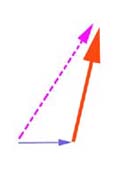 |
 So you are saying that we can think of the electric forces in a light wave in
the same way?
So you are saying that we can think of the electric forces in a light wave in
the same way?
 Yes, the electric forces in one yellow plane of polarization are completely
equivalent to the electric forces in a vertical yellow plane PLUS the
forces in a horizontal yellow plane, just as below. This is called "breaking
the light up into horizontal and vertical components".
Yes, the electric forces in one yellow plane of polarization are completely
equivalent to the electric forces in a vertical yellow plane PLUS the
forces in a horizontal yellow plane, just as below. This is called "breaking
the light up into horizontal and vertical components".
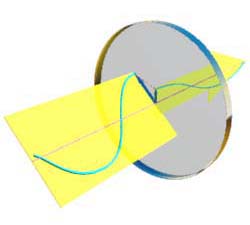 |
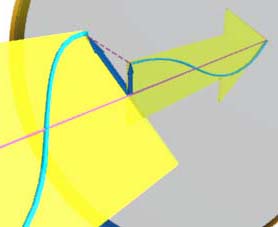 |
 You can always imagine breaking light into horizontal and vertical
(polarization) components. This is true whether the light on the left is
polarized or unpolarized, but temporarily polarized in the plane shown on the
left.
You can always imagine breaking light into horizontal and vertical
(polarization) components. This is true whether the light on the left is
polarized or unpolarized, but temporarily polarized in the plane shown on the
left.
 Now I understand what polarized light is, but I guess I still don't understand
how it gets polarized in the first place. Why were we able to polarize light
with the sunglasses?
Now I understand what polarized light is, but I guess I still don't understand
how it gets polarized in the first place. Why were we able to polarize light
with the sunglasses?
 In order to polarize light, you need to pass it through some kind of filter. A
good example of this is a Polaroid filter. This kind of filter is made up of
parallel strands of long molecules. Let's think of a lens where these strands
are horizontal. The energy of the horizontal components of light is
absorbed by the strands, so this part cannot pass through. The vertical
components can pass through, however, because the horizontal strands cannot
absorb their energy.
In order to polarize light, you need to pass it through some kind of filter. A
good example of this is a Polaroid filter. This kind of filter is made up of
parallel strands of long molecules. Let's think of a lens where these strands
are horizontal. The energy of the horizontal components of light is
absorbed by the strands, so this part cannot pass through. The vertical
components can pass through, however, because the horizontal strands cannot
absorb their energy.
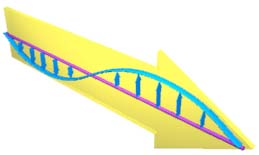
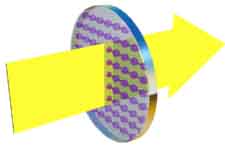 |
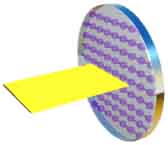 |
 So the filter selects one component from all of the different planes of light
and lets that one component get through! That's why light that's polarized in
the horizontal plane can't get through a filter that's absorbing the
horizontal components of the light.
So the filter selects one component from all of the different planes of light
and lets that one component get through! That's why light that's polarized in
the horizontal plane can't get through a filter that's absorbing the
horizontal components of the light.
 You've got it, Kyla. We've seen what happens to light when it passes through
one lens, but more exciting things start to happen when it passes through a
few lenses...
You've got it, Kyla. We've seen what happens to light when it passes through
one lens, but more exciting things start to happen when it passes through a
few lenses...






